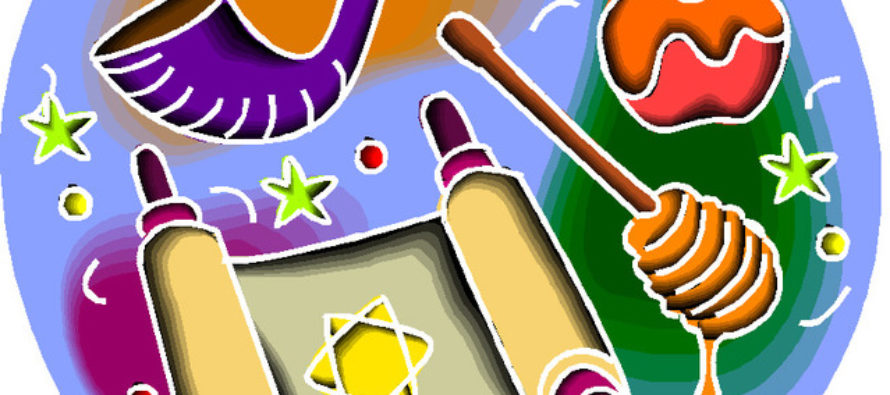
Rosh Hashanah holiday guide

Rosh Hashanah begins this year on Wednesday evening, September 8, and continues through nightfall of September 10. What follows is a how-to guide to the basics of Rosh Hashanah observance.
Rosh Hashanah in a Nutshell
The festival of Rosh Hashanah – the name means “Head of the Year” – is observed for two days beginning on Tishrei 1, the first day of the Jewish year. It is the anniversary of the creation of Adam and Eve, the first man and woman, and their first actions toward the realization of mankind’s role in G-d’s world.
Rosh Hashanah thus emphasizes the special relationship between G-d and humanity: our dependence upon G-d as our creator and sustainer, and G-d’s dependence upon us as the ones who make His presence known and felt in His world. Each year on Rosh Hashanah, “all inhabitants of the world pass before G-d like a flock of sheep,” and it is decreed in the heavenly court, “who shall live, and who shall die… who shall be impoverished, and who shall be enriched; who shall fall and who shall rise.” But this is also the day we proclaim G-d King of the Universe. The Kabbalists teach that the continued existence of the universe is dependent upon the renewal of the divine desire for a world when we accept G-d’s kingship each year on Rosh Hashanah.
The central observance of Rosh Hashanah is the sounding of the shofar, the ram’s horn, which also represents the trumpet blast of a people’s coronation of their king. The cry of the shofar is also a call to repentance; for Rosh Hashanah is also the anniversary of man’s first sin and his repentance thereof, and serves as the first of the “Ten Days of Repentance” which culminate in Yom Kippur, the Day of Atonement. Altogether, we listen to 100 shofar blasts over the course of the Rosh Hashanah service.
Additional Rosh Hashanah observances include:
a) Eating a piece of apple dipped in honey to symbolize our desire for a sweet year, and other special foods symbolic of the new year’s blessings.
b) Blessing one another with the words Leshanah tovah tikateiv veteichateim, “May you be inscribed and sealed for a good year.”
c) Tashlich, a special prayer said near a body of water (an ocean, river, pond, etc.) in evocation of the verse, “And You shall cast their sins into the depths of the sea.” And as with every major Jewish holiday, after candlelighting and prayers we recite Kiddush and make a blessing on the Challah.
Rosh Hashanah How-To:
Day Before Rosh Hashanah
The recitation of Selichot — a series of penitential prayers and liturgy recited daily in preparation for the Days of Awe — reaches its climax with the recitation of the “Zechor Brit” (“Remember Your Covenant”) Selichot on the day before Rosh Hashanah.
This day’s Selichot, which is slightly lengthier than the preceding days’, is customarily said in the very early hours of the morning. In most synagogues, the Selichot are immediately followed by the morning prayers. Click HERE for the Hebrew text of the Selichot.
The shofar is not sounded on the day before Rosh Hashanah (as it is every day throughout the previous month of Elul), to separate between the shofar soundings of the month of Elul — which are a minhag, or “custom” — and the Rosh Hashanah soundings, which are a biblically ordained mitzvah.
Another reason given for not sounding the shofar on this day is in order to confuse Satan, the supernal prosecutor, as he prepares his case against us for tomorrow’s Day of Judgment. The blowing of the shofar is a great weapon in our arsenal. When Satan sees that we are so confident that we will be victorious on the Day of Judgment that we don’t even find it necessary any more to sound the shofar, he is utterly confounded and loses confidence in his carefully prepared case.
After the morning prayers, it is customary to perform a ceremony known as Hatarat Nedarim (“the annulment of vows”) to repeal certain vows which one has taken upon oneself so that one can begin the Day of Judgment free from the sin of unfulfilled vows.
Certain vows which one has accepted upon oneself can, legally, be repealed by a court of three people. Many communities, including Chabad, have the custom of doing so before an assembly of ten individuals. The person approaches the panel and declares that he had possibly accepted vows upon himself, but had he known that he would be unable to fulfill them, he would never have accepted them upon himself. The person is then told three times that his vows are annuled.
On the day before Rosh Hashanah it is customary to visit the graves of tzaddikim (righteous, saintly people) and there to pray for a sweet new year. We ask the tzaddikim to intercede On High on our behalf, and we pray to G-d to have mercy on us in the merit of these righteous people at whose resting places we are standing.
It is customary for men to visit a mikvah.
On the day before Rosh Hashanah, every spare moment should be spent reciting Psalms. Thus, one already enters the new year with a clean slate. The continuous Psalms recitation should continue throughout the 48 hours of Rosh Hashanah.
It is forbidden on a holiday to do any act in preparation for the following day, even if the following day is Shabbat. However, the sages created a halachic device, called an eruv tavshilin, which allows one to cook food on a holiday day for use on a Shabbat that immediately follows it.
If a holiday day — whether the first or second day of a holiday — falls on a Friday, an eruv tavshilin is set aside on the day preceding the holiday (Wednesday or Thursday afternoon), so that we will be permitted to prepare for Shabbat (cooking as well as any other necessary preparations) on the holiday. Only one eruv is required per household.
This year (5771-2010), Rosh Hashanah falls on Thursday and Friday, so an eruv tavshilin is made on Wednesday afternoon before the holiday candles are kindled.
This eruv consists of a challah or two matzahs, and a cooked food, such as meat, fish, or an unpeeled hard-boiled egg.
Click HERE for the eruv tavshilin procedure, and HERE for more on eruv tavshilin.
Rosh Hashana Eve
Girls and all women that are in the house (or if there isn’t a woman in the house, the head of the household), light candles to usher in each night of the holiday, and then Shabbat. Follow this LINK for detailed holiday candle-lighting time information, and this LINK for local candle lighting times.
On the first night of Rosh Hashanah, it is customary to greet one another with blessings and good wishes of Leshana tova tekatev v’etachetem — May you be inscribed for a good year!
Before starting the Rosh Hashanah meal, we sanctify the holiday by reciting the kiddush over a cup of wine or grape juice. Click HERE for the text of the kiddush.
On the second night of Rosh Hashanah, a “new fruit,” i.e., a seasonal fruit which we have not yet tasted since its season began, should be present on the table when the holiday candles are kindled and during the kiddush. While reciting the Shehecheyanu blessing after candle-lighting and after the
kiddush, one should have the new fruit in mind. This fruit is eaten following the kiddush, before washing for bread. Before partaking of the fruit we say the blessing.
Immediately following the kiddush (and on the second night, the eating of the new fruit), we perform the ritual washing for bread. After reciting the Hamotzie blessing, cut the challah, dip it in honey (some also dip it in salt), and have a bite. Pass around pieces and make sure everyone does the same.
On the first day of Rosh Hashanah, after the afternoon prayer, we go to a lake, river or sea (preferably a body of water that has fish), and recite the Tashlich prayers, wherein we symbolically cast our sins into the water and leave our old shortcomings behind us, thus starting the new year with a clean slate.
If one is unable to perform this ceremony on Rosh Hashanah, one may do so until the last day of Sukkot (this year September 29, 2010).
Useful Rosh Hashanah Links:
Rosh Hashanah Mega-Site
Global Rosh Hashanah Service & Event Finder
Holiday Study & Insights
Rosh Hashanah Stories
High Holiday Shopping
Rosh Hashanah Kids’ Zone
Traditional Rosh Hashanah Recipes
Rosh Hashanah Audio Classes, Videos & Songs
High Holidays E-Greeting Cards
The Ohmygossip.com staff wishes you and yours a happy and healthy New Year!

 High quality & nature friendly luxury cosmetics from Scandinavia - ElishevaShoshana.com
High quality & nature friendly luxury cosmetics from Scandinavia - ElishevaShoshana.com

